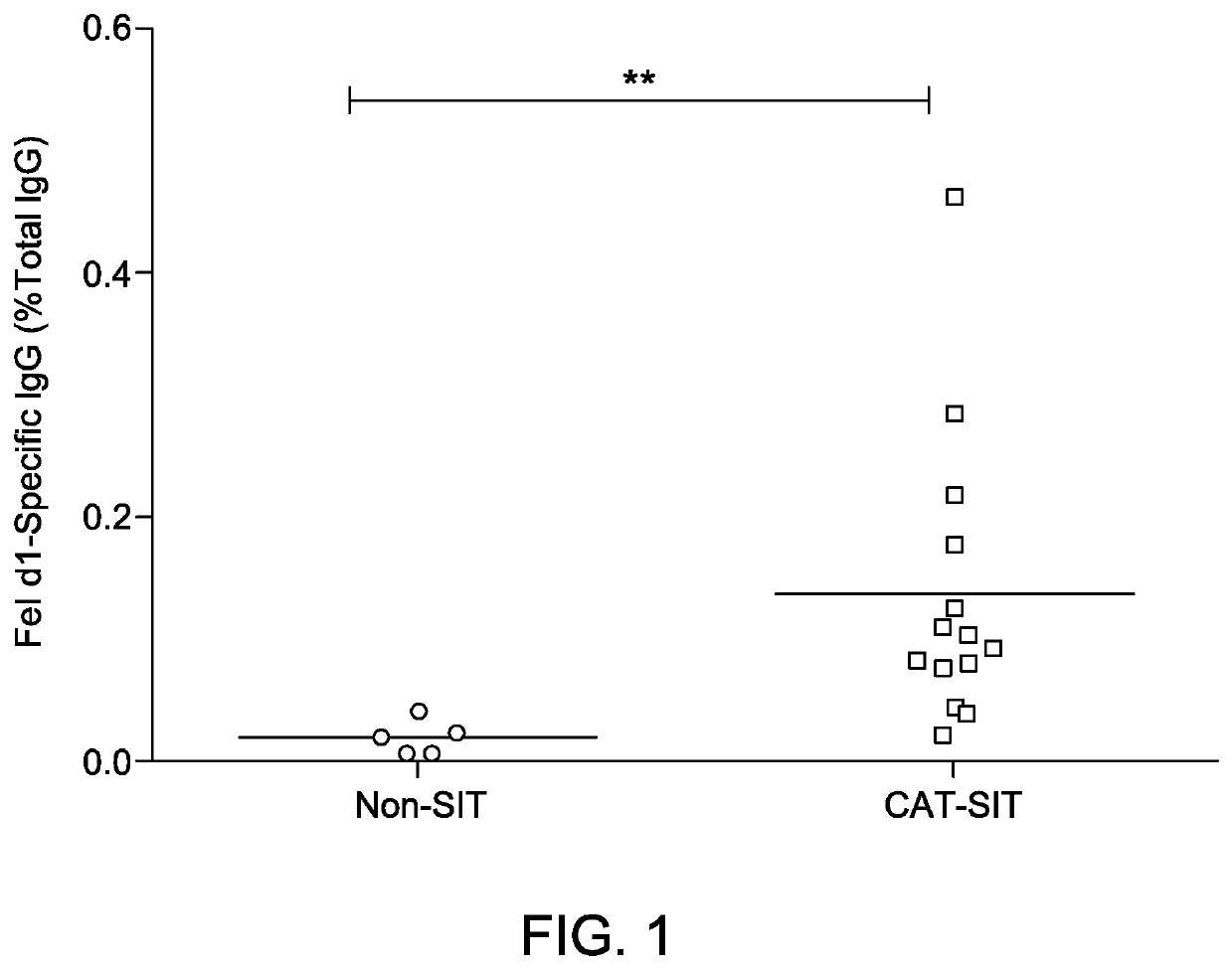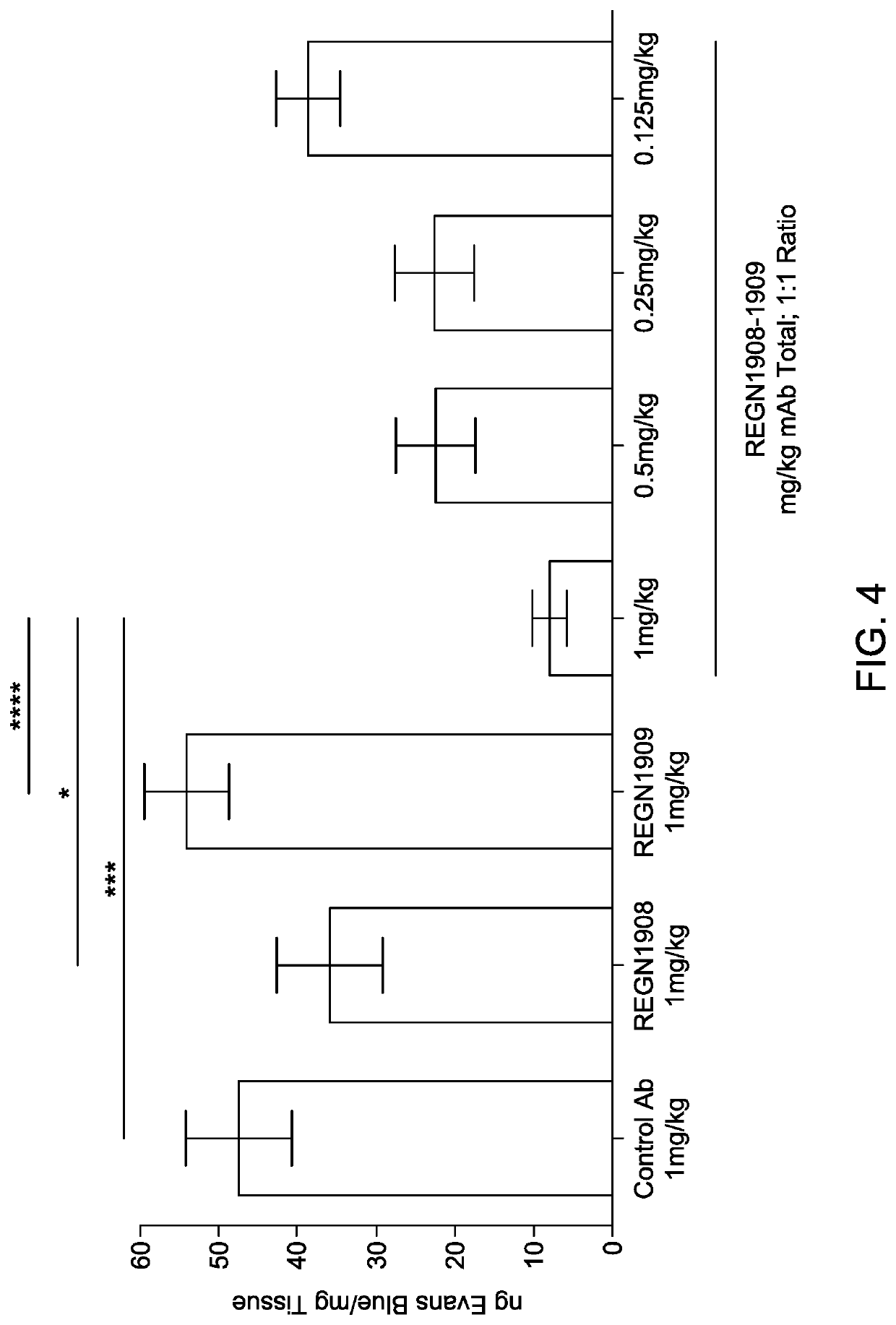Method of treating an allergy with allergen-specific monoclonal antibodies
a monoclonal antibody and allergy technology, applied in antibody medical ingredients, immunological disorders, drug compositions, etc., can solve the problems of adverse reaction risk, severe allergic response risk in sensitized individuals, etc., to prevent more serious in vivo complications, reduce, minimize, or prevent at least one symptom
- Summary
- Abstract
- Description
- Claims
- Application Information
AI Technical Summary
Benefits of technology
Problems solved by technology
Method used
Image
Examples
example 1
n of Human Antibodies to Fel d1
[0351]An immunogen comprising any one of the following can be used to generate antibodies to Fel d1. In certain embodiments, the antibodies of the invention are obtained from mice immunized with a primary immunogen, such as full length natural Fel d1 (nFel d1), which may be purchased commercially (e.g., from Indoor Biotechnologies, # LTN-FD1-1), or isolated from cat hair or dander by multi-step column chromatography (See, for example, Chapman M D, et al. (1988), J. Immunol. 140:812-818), or which may be produced recombinantly (See GenBank accession numbers P30438, or NP_001041618.1 for the full length amino acid sequence of chain 1 of Fel d1 (also referred to as chain A or FELD1 A; also see SEQ ID NO: 392) and GenBank accession number P30440, or NP_001041619.1 for the full length amino acid sequence of chain 2 of Fel d1 (also referred to as chain B or FELD B; also see SEQ ID NO: 393), or fragments of either chain 1 or chain 2, or fragments from both ch...
example 2
Light Chain Variable Region Amino Acid Sequences
[0360]Table 1 sets forth the heavy and light chain variable region amino acid sequence pairs of selected antibodies specific for Fel d1 and their corresponding antibody identifiers. Antibodies are typically referred to herein according to the following nomenclature: Fc prefix (e.g. “H4H”, “H1M, “H2M”), followed by a numerical identifier (e.g. “1232” as shown in Table 1), followed by a “P” or “N” suffix. Thus, according to this nomenclature, an antibody may be referred to as, e.g. “H1M1232N”. The H4H, H1M, and H2M prefixes on the antibody designations used herein indicate the particular Fc region of the antibody. For example, an “H2M” antibody has a mouse IgG2 Fc, whereas an “H4H” antibody has a human IgG4 Fc. As will be appreciated by a person of ordinary skill in the art, an H1M or H2M antibody can be converted to an H4H antibody, and vice versa, but in any event, the variable domains (including the CDRs), which are indicated by the n...
example 3
Gene Utilization Analysis
[0362]To analyze the structure of antibodies produced, the nucleic acids encoding antibody variable regions were cloned and sequenced. From the nucleic acid sequence and predicted amino acid sequence of the antibodies, gene usage (VH, D, JH, VK, or JK) was identified for each Heavy Chain Variable Region (HCVR) and Light Chain Variable Region (LCVR). Table 2 sets forth the gene usage for selected antibodies in accordance with the invention.
TABLE 2AntibodyAntibodyIdentifierHCVRLCVRPIDHCVR / LCVRVHDJHVKJKH1M1230N 2 / 103-7 6-1361-125H4H1232N18 / 263-212-1561-272H1M1234N34 / 426-1 1-7 44-1 4H1M1241N50 / 583-212-2 61-174H4H1300N66 / 741-2 5-1244-1 2H2M1233N82 / 903-336-1941-5 1H2M1236N 98 / 1054-591-7 41-332H2M1237N114 / 1223-336-1941-5 1H4H1238N130 / 1384-591-7 41-332H2M1242N146 / 1543-215-1241-5 1H4H1616N162 / 1703-236-1341-333H4H2574P178 / 1864-396-1933-202H4H2590S194 / 2023-116-6 46-211H4H2592B210 / 2183-111-2646-211H4H2594S226 / 2343-116-6 41-164H4H2597P242 / 2503-116-6 46-211H4H2606B258 / 266...
PUM
| Property | Measurement | Unit |
|---|---|---|
| equilibrium dissociation constant | aaaaa | aaaaa |
| length | aaaaa | aaaaa |
| length | aaaaa | aaaaa |
Abstract
Description
Claims
Application Information
 Login to View More
Login to View More - R&D
- Intellectual Property
- Life Sciences
- Materials
- Tech Scout
- Unparalleled Data Quality
- Higher Quality Content
- 60% Fewer Hallucinations
Browse by: Latest US Patents, China's latest patents, Technical Efficacy Thesaurus, Application Domain, Technology Topic, Popular Technical Reports.
© 2025 PatSnap. All rights reserved.Legal|Privacy policy|Modern Slavery Act Transparency Statement|Sitemap|About US| Contact US: help@patsnap.com



